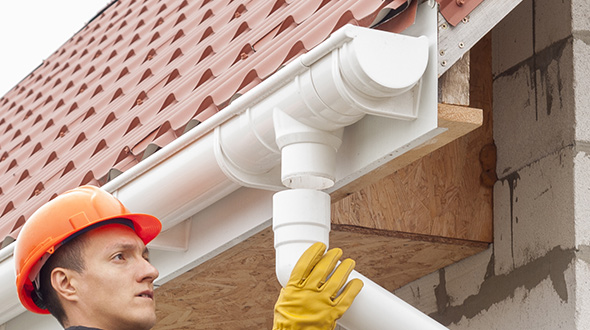
Prevent your flat roof system from collapsing under the weight of standing rainwater. Without sufficient drainage, water can build up on your commercial roof and cause catastrophic losses when the roof succumbs.
atlantacommercialroofingcontractors.com gathered information on three roof water drainage systems and how they remove potentially thousands of pounds of water from your commercial flat roofing system.
Roof Drain Types
Whether you are installing a new roof or performing renovations on an old roof, the drainage system must be considered and able to usher water off of the roof with ease. The following are three principal flat roof drainage systems:
Inner Drains – These drains are commonly found on large building roofs near the center of the building. Inner drains provide the following benefits:
• Attached to a system of pipes that drain water through the roof, water is kept from the foundation and walls.
• Since the building and walls naturally protect inner drains, there is no concern for their freezing, cracking, or failing during the winter months.
• Inner drain strainers help keep debris from clogging the drain pipes and can be custom-made to fit your roof and regional climate.

Some essential issues to take into consideration are:
• A small amount of debris can render the strainers ineffective, clog the system, and cause water to pool on your roof.
• Verify the appropriate number of drains for the size of your roof. Too few drains and the system could easily be overloaded, causing water to back up and pool on your roof.
• Inner drains are more expensive to maintain. These drains require a specialized technician to service, clean, and maintain them.
• Of the three drain systems presented here, inner drains are the most expensive to install.
Rain Gutters – With the ability to serve all types of roofing systems, rain gutters together with downspouts are the most common type of water drainage system in use. Gutters offer the following benefits:
• The system is inexpensive
• Easy to install
• Effectively controls the flow of watershed from a roofing system
• Shields doorways, vents, and windows
• Keeps water from pooling near the building

Some essential issues to take into consideration are:
• Gutters require maintenance and cleaning year-round
• Gutters are prone to becoming brittle and cracking
• Gutter brackets may come loose or give way under excessive water or leaf weight
• In winter, ice dams can cause cracking
• Downspouts may clog causing water to back up and overflow in the gutter
Scuppers – This drainage system consists of along the outer walls (curbs) along the roofline. Water passes through a metal box that surrounds and protects the scupper. Consider the following benefits:
• Installation of the drainage system is extremely low cost
• If designed wide enough, there is virtually no clogging
• Water is propelled away from the building
• Custom scuppers can add to the building’s architectural appeal
• This draining system is almost maintenance-free
When the design and installation of scuppers are carried out correctly, the system provides the best value of the different drainage systems. Thus, scuppers are preferred for the efficient draining of water from your flat roof system.
The only issue with scuppers is when they are attached to downspouts or gutters, which may clog – scuppers function best when unattached from other systems.

Roof Load and Water Weight
Water removal from your roofing system is of supreme importance. As water pools and rises, it adds weight to your roof’s load and can cause a catastrophic roofing system failure.
A gallon of water weighs 8.34 pounds. During a rainstorm that drops a half-inch of rain, 300 gallons of water can accumulate on a 1,000 square foot roof. That is an additional 2,502 pounds added to your roof’s load.
To calculate rainfall accumulation or runoff, use the following equation:
1) Convert the footprint of your roof to inches. A 50’ by 50’ roof would be 600” by 600.”
2) Multiply the square footage of the roof (600” X 600” = 360,000”) by the number of inches of rainfall .5” for this example which equals 180,000
3) Divide the number by 231 to get the number of gallons (231 cubic inches = 1 gallon). In this case, 180,000 divided by 231 equals 779.22
4) 780 gallons of water weighs about 6,500 pounds, potentially added to your roof.
In this example, we see the potential for a roofing system partial or total failure due to an exceeded load capacity. To learn more about commercial roof loads, read atlantacommercialroofingcontractors.com/what-is-commercial-roof-load-why-you-need-to-know/
Commercial Roof Drainage Systems
In this article, you discovered information about three types of water drainage systems for commercial roofs and the impact that pooling water can have on your roof load.
By installing a drainage system that facilitates water runoff from your roof, you are extending the life of your roof and making the building a safer place to be.
If you fail to provide adequate drainage or regular maintenance to keep your systems working properly, the structural integrity of the roof, building, and its occupants are at risk.
Sources:
http://www.ashireporter.org/HomeInspection/Articles/Flat-Roof-Drainage/2554
citeseerx.ist.psu.edu/viewdoc/download?doi=10.1.1.359.7775&rep=rep1&type=pdf
digitalcommons.calpoly.edu/cgi/viewcontent.cgi?referer=&httpsredir=1&article=1069&context=aen_fac
sciencenotes.org/much-gallon-water-weigh-easy-calculation/
